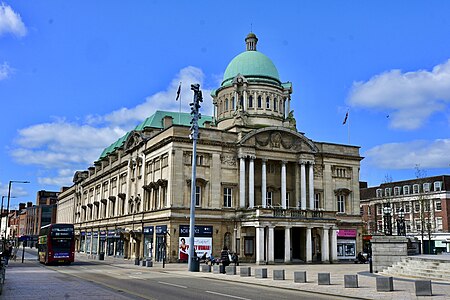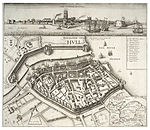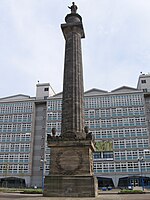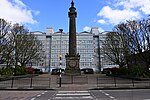Kingston upon Hull

Kingston upon Hull, usually abbreviated to Hull, is a port city and unitary authority area in the East Riding of Yorkshire, England. It lies upon the River Hull at its confluence with the Humber Estuary, 25 miles (40 km) inland from the North Sea and 37 miles (60 km) south-east of York, the historic county town. With a population of 266,463 (2021), it is the fourth-largest city in the Yorkshire and the Humber region after Leeds, Sheffield and Bradford. The town of Wyke on Hull was founded late in the 12th century by the monks of Meaux Abbey as a port from which to export their wool. Renamed Kings-town upon Hull in 1299, Hull had been a market town, military supply port, trading centre, fishing and whaling centre and industrial metropolis. Hull was an early theatre of battle in the English Civil Wars. Its 18th-century Member of Parliament, William Wilberforce, took a prominent part in the abolition of the slave trade in Britain.More than 95% of the city was damaged or destroyed in the blitz and suffered a period of post-industrial decline (social deprivation, education and policing). The destroyed areas of the city were rebuilt in the post-Second World War period. In the early 21st century spending boom before the late 2000s recession the city saw large amounts of new retail, commercial, housing and public service construction spending. In 2017, it was the UK City of Culture and hosted the Turner Prize at the city's Ferens Art Gallery. Other notable landmarks in the city are the Minster, the tidal surge barrier, the Paragon Interchange and The Deep aquarium. Areas of the town centre include the old town (including its museum quarter) and the marina. Hull University was founded in 1927 and had over 16,000 students in 2022. Rugby league football teams include clubs Hull F.C. and Hull Kingston Rovers. The city's association football club is Hull City (EFL Championship). Hull RUFC and Hull Ionians both play in the National League 2 North of rugby union.
Excerpt from the Wikipedia article Kingston upon Hull (License: CC BY-SA 3.0, Authors, Images).Kingston upon Hull
Lowgate, Hull Old Town
Geographical coordinates (GPS) Address Nearby Places Show on map
Geographical coordinates (GPS)
| Latitude | Longitude |
|---|---|
| N 53.744444444444 ° | E -0.3325 ° |
Address
Lowgate
Lowgate
HU1 1HP Hull, Old Town
England, United Kingdom
Open on Google Maps








